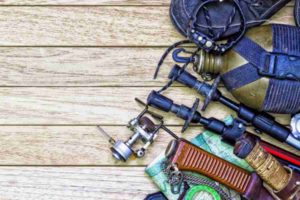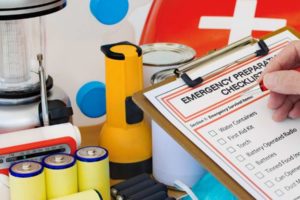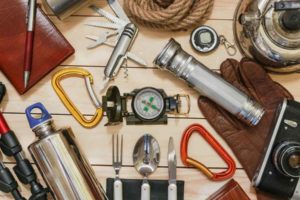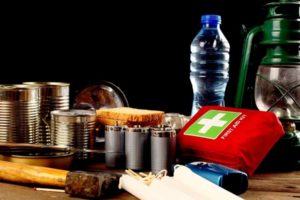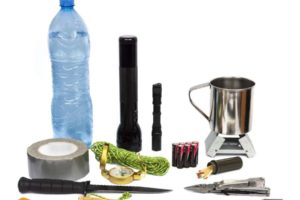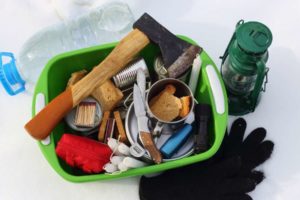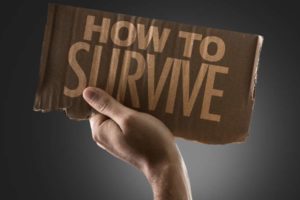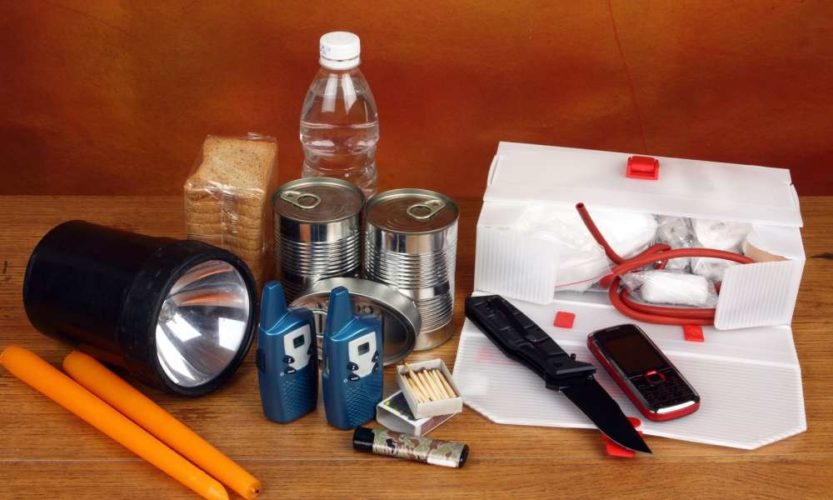
It is always a good idea to prepare a kit of items specifically for emergencies. Whether your plan includes creating solutions for problems related to a natural disaster, or planning out a backpacking trip or camping excursion, including survival gear on the list is important. It could happen; you might have to fend for yourself for numerous hours, even days, before any kind of help arrives on the scene.
Home survival kits
Survival kits for the home should be a requirement for each household in the country. A home survival kit should include items that will help families during emergencies and natural disasters, like storms and power outages.
Each survival kit must have crucial items like food and water, first aid kits, medicines, bedding, flashlights and some kind of electronic communication device like an AM/FM radio that can run on batteries. Families must always be prepared for situations whenever they cannot get out of the house for a number of days.
A survival kit can be stored in duffel bags or camping packs, or any sealable plastic bag. The bags should also be water-resistant in order to keep the items dry.
Here are some of the items that should be stored in a survival kit:
Food and water
The first thing that you have to consider is food and water. Remember that tap water can be different in every area; thus, you have to purchase water purification tablets which can get rid of harmful microbes. You can also rely on other effective forms of water filtration/purification like specialized straws or pens.
Bottled water is also a necessity if you do not have any running water available. Make sure that you have at least a gallon of water for every person in the household.
The amount of survival food that you should store will be based on personal needs and preferences. You must always plan to keep at least a week’s supply of food at a minimum. The presence of a food supply that will last for at least 4 weeks will give everybody relief.
Opt for non-perishable items like canned goods, powdered milk, pasta, dried fruit, nuts and protein food bars. You can also go for freeze-dried foods since they have a longer shelf life (12-20 years or more), and they have more variety. They are also available for breakfast, lunch and dinner meals.
First aid
A household that is prepared has a first aid kit for home use and another for every vehicle the homeowner has.
The American Red Cross recommends that every first aid kit must contain different-sized bandages, roller gauze bandage, antiseptic dressing, 2 triangular bandages. 2” x 3” sterile gauze pads, 2-4” x 4” antiseptic gauze pads, a roll of 3” adhesive bandage, a cold pack, tweezers, scissors and anti-bacterial ointment. Having an emergency blanket, a knife, and waterproof matches is also a good idea.
Important over-the-counter medicines include pain relievers, aspirin, laxatives, antacids and activated charcoal which can be used to encourage vomiting if suggested by the Poison Control Center. Anti-diarrhea medicine is also important, particularly in locations where the supply of drinking water is inadequate.
Keep in mind to store prescription medicines on hand as well, plus any medications for pets, and solution for your contact lenses.
Sanitation and hygiene
A good kit must include items like moist hand wipes, personal hygiene implements, chlorine bleach, medicine droppers, waste bags, and toiletries.
Tools and electronics
The best survival kit should include a flashlight and spare batteries, a cellphone with charger and a battery-powered or hand-cranked radio.
Furthermore, having an excellent multi-purpose tool or work knife around is essential, and will prove to be helpful under certain circumstances. You can count on the old standard, the Swiss Army knife. Including a whistle in the kit may also be handy.
Important documents and cash
Every survival kit should include money from small bills down to additional credit cards. It is also good if individuals keep a current bank statement with them, or their latest ATM receipt. Remember to gather copies of important documents, IDs and insurance policies, and keep them all in a waterproof, compact container.
Clothing
Individuals should at the least include two changes of clothes in the kit, plus a pair of comfortable shoes. This change of clothes should include long pants and a long-sleeved shirt.
Wilderness survival gear and kit
A survival kit means the individual who has it will be capable of dealing with anything that they might face along the way, regardless of whether they will be trekking and exploring, or camping in the woods. An excellent wilderness survival kit should be lightweight, waterproof and easy to carry/transport, yet still provide room for each and every item you own.
Parka
A downsized, folded parka should always be included in every wilderness survival kit. You might face rain at unanticipated times, and the parka will provide warmth and security from unneeded contact with sizable quantities of moisture.
Tent
Make sure to include a compact emergency tent in the bag. These smaller tents are about the size of a big envelope and will take minimal space yet will offer sufficient protection for users from the weather.
Waterproof matches
Always remember to include waterproof matches in a wilderness survival kit so you can build fires to cook food, provide warmth, or make signals. The waterproof kind are the best since they will stay dry.
Blanket
Include a blanket for your overnight hikes or backpacking trips. A wool blanket will offer a significant amount of warmth. You can also include a downsized emergency blanket with you in the event that you have to camp out without prior notice.
Emergency blankets are quite compact once they are folded. They are also provided with linings with reflective material to trap body heat and keep the user warm throughout.
Food
Make sure to choose non-perishable food for a forest survival kit, like dried fruits or nuts. If you can, you may also want to include freeze-dried food in the kit. Throw in some protein bars and beef jerky into the mix as well for energy.
Water
The bottled kind can be heavy and hefty so instead, choose water purification tablets or any handy water purification or filtration system that’s available on the market. This is especially useful if you are going to spend several days in the forest or wilderness. It is still a good idea though, to pack at least 2 water bottles with you in the event that there are no water sources available in the area.
First aid kit
Set up a standard first aid kit; this will include items such as gauze bandages, antibiotic ointments, medical tape, scissors, tweezers, burn ointment, sunscreen and any medicines that you are taking.
Compass
Choose a compact, waterproof compass for the kit. A compass will be a great partner in guaranteeing that you will not get lost.
Knife
Pick a camping knife that is capable of cutting tree branches and fending off bushes. The knife might also be utilized for preparing food and as protection against wild animals.
Whistle
Make sure to select a tiny whistle for the survival kit in the event that you become injured or lost, and need assistance.
Staying alive in the city during a disaster
Whenever we discuss surviving in the city, we are not discussing safeguarding ourselves with weapons. Although weapons are needed for self-protection as well, there are ways in which you can protect yourself further in times of disasters. Here are some suggestions:
Maintain your health and fitness
Sometimes in order to be truly prepared, you have to be in tiptop shape; make sure to keep your health and fitness in check. If you want to endure critical situations, you have to be fit, both physically and mentally. Begin a workout routine to improve your stamina and strength.
Start following a healthier diet and at least try to be active at all times. This approach will provide you with sufficient strength to manage any kind of disaster.
Remember aware of your environment all the time
It is important that you should always be aware of the world you live in. This is the most important factor to remember anywhere you live. Any strange location can be prone to natural disasters or terrorist attacks. Hence, if you are new to a location, it is always suggested that you start a comprehensive examination of the place before you explore.
If you are on the way to central locations, remember to be aware of individuals around you to avoid any likely danger to you or other individuals.
Create or invest in a survival kit
This is something that experts often recommend; having a survival kit around will extend your chances of enduring any kind of disaster that can strike at any time. Bear in mind that the best survival kit is lightweight and compact enough for comfortable and easy transportation. The user must be capable of carrying the kit without any troubles anywhere he or she goes.
The kit should also be prepacked with all of the needed items beforehand to prevent missing out on essentials at the last minute.
Learn survival skills and self-defense
Another crucial suggestion is for individuals to learn a number of survival skills. These capabilities include making a temporary shelter, filtering/purifying water, basic medical techniques and different types of self-defense.
Image | Product | Price | Rating |
| Gerber Zombie Apocalypse Survival Kit | $$$ | 4.6/5 | |
| Urban Survival Bug Out Bag | $$ | 4.3/5 | |
| PREPPER’S FAVORITE: Emergency Get Home Bag with First Aid Kit | $$ | 4.7/5 | |
| Life Gear Wings of Life Emergency Survival Kit | $$ | 3.5/5 | |
| Mountain House Just in Case 72 Hour Kit | $ | 4.5/5 | |
| 4 Person Perfect Survival Kit Deluxe | $$ | 4.5/5 | |
| Extreme Survival Kit Four For Earthquakes | $$ | 5.0/5 | |
| AMC’s The Walking Dead Survival Kit – Two Person | $$ | 4.4/5 | |
| Lansky LTASK T.A.S.K. Tactical Apocalypse Survival Kit | $$ | 4.0/5 | |
| Ready America 70385 Deluxe Emergency Kit 4 Person Backpack | $ | 4.2/5 |
5 Survival Kit Suggestion
Now that we have discussed survival essentials, we can move on to five survival gear and kit recommendations. These items thus far have earned plenty of positive responses from customers all over. Browse the list and make sure to list down items that made your grade.
Gerber Zombie Apocalypse Survival Kit
You will have an adequate supply of knives if you purchase a Gerber Zombie Apocalypse Survival Kit. The kit includes a total of 7 tools from 6 knives to an all-purpose axe. The set has machetes from Gator, the Gator Machete Pro and the parang. It has knives like the Epic knife, the DMF Folder, and the MLF II Infantry.
The set also includes the Camp Axe II from Gerber. Now if you want to add a set of sharp objects next to your survival food list, this kit might be it. Perfect for a zombie invasion and a trek in the woods.
Pros
- Excellent LMF II knife
- Sheath can also be used as a hammer handle and a sharpener
- Camp Axe II is dependable
- DMF Folder has a sharp blade and good lock-up
Cons
- Gator Pro and parang have poor designs according to some customers
- Hook is unreliable
- Epic is too heavy
Emergency Zone Urban Survival Bug Out Bag
Emergency Zone’s Urban Survival Bug Out Bag was designed and created to meet individuals’ needs and safety during times of disaster. This is a black backpack with a discrete style was aimed to blend in with the crowd.
Contained inside the backpack are items that you need in order to go through the day, and it can fit the requirements of 2 individuals for 72 hours, or a single person for 144 hours. If you are on the hunt for a bag that contains all necessities, then this survival kit is something you need.
Pros
- Discrete backpack does not have labels
- Fits the needs of 2 individuals for 72 hours and 1 person for 144 hours
- Great for storing at home, the office, or the car
- Made in the US
- Includes food, hygiene items, weather protection, lighting and communication items and other implements
Cons
Some customers found the bag low in quality
Prepper’s Favorite: Complete Get Home Bag
For families who have loved ones living away from home, it is always good if they give them a survival bag that they can use in times of disaster. Preparedness is key in survival, and a survival kit, like this one from Prepper’s Favorite, will tide your loved ones over through the day.
It includes crucial items from food, a water filtration system, a fire-starting setup, a first aid kit with a guide, and a sleeping bag. In the aftermath of disasters like floods, earthquakes, wildfires and power failures, having this item on hand will ensure that your family will be safe and secure.
These Get Home Bags are designed to offer their users the important elements they need to bring them back home to their families.
Pros
- Durable, tough bag
- Includes effective water filtration system
- Includes comfortable sleeping bag
- Has great food items
- 57-piece first aid kit with guide
- Includes its own fire-starter kit
Cons
One customer complained the bag did not allow more space for additions
Life Gear Wings of Life Emergency Survival Kit
Life Gear’s Wings of Life is something that you can check out if you are on the hunt for a survival kit. This is a functional pack that is ergonomic and useful, with necessities that you may need during an emergency.
The pack features adjustable straps, a number of storage pockets, and is made with lightweight, quality water-resistant material. It is comfortable enough for use every day, and even kids can use it as well. This product promises to be adequate during tough conditions, and will easily cater to the requirements of campers and hikers.
Pros
- Includes first aid kit
- Includes hygiene kit
- Includes red emergency flasher
- Backpack features ergonomic design
- Has multiple storage pockets
- Comfortable fit and carries well
Cons
- Some customers said the backpack’s material is not durable enough
- Does not include important items like a fire-starting kit, a water filtration system, flashlights and a collapsible water container
- Expensive for a kit that does not contain certain essentials
Mountain House Just in Case 72 Hour Kit
Mountain House’s Just in Case 72 Hour Kit includes a nice selection of meals which will satisfy individuals during emergency situations, thus, having them around the house, the workplace or in your backpack will be there when and if you need them.
The kit covers breakfast, lunch, and dinner; it has 1 granola with milk and blueberries, and 2 scrambled eggs with bacon for breakfast; and 2 beef stroganoffs with noodles, 2 chicken teriyakis with rice, 1 rice and chicken and 1 pasta primavera for lunch and dinner.
All you need is to add water in order to cook your meals, and you are done. These packs are popular, and with good reason—they are excellent emergency rations.
Pros
- Great selection of dishes for every meal
- Has long shelf life of over 12 years
- You only have to add water to cook the meals
- Lightweight and can cover one person for 72 hours
Cons
Low-calorie count so individuals have to eat more than one pack to satisfy calorie requirements
Conclusion
Having your own survival kit or gear on hand will eliminate the need for searching for crucial items when you need them most. Warnings of impending natural disasters like blizzards and hurricanes will make individuals rush to the stores and stock up on food, hygiene and first aid supplies.
In case you are traveling using a vehicle, or have plans to be out of doors, the presence of a survival kit will allow you and your family to bear up during tough times. Choose a kit or gear that will rightfully serve you and your family’s needs.
